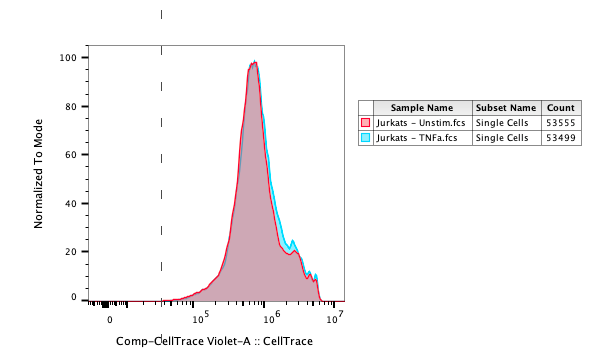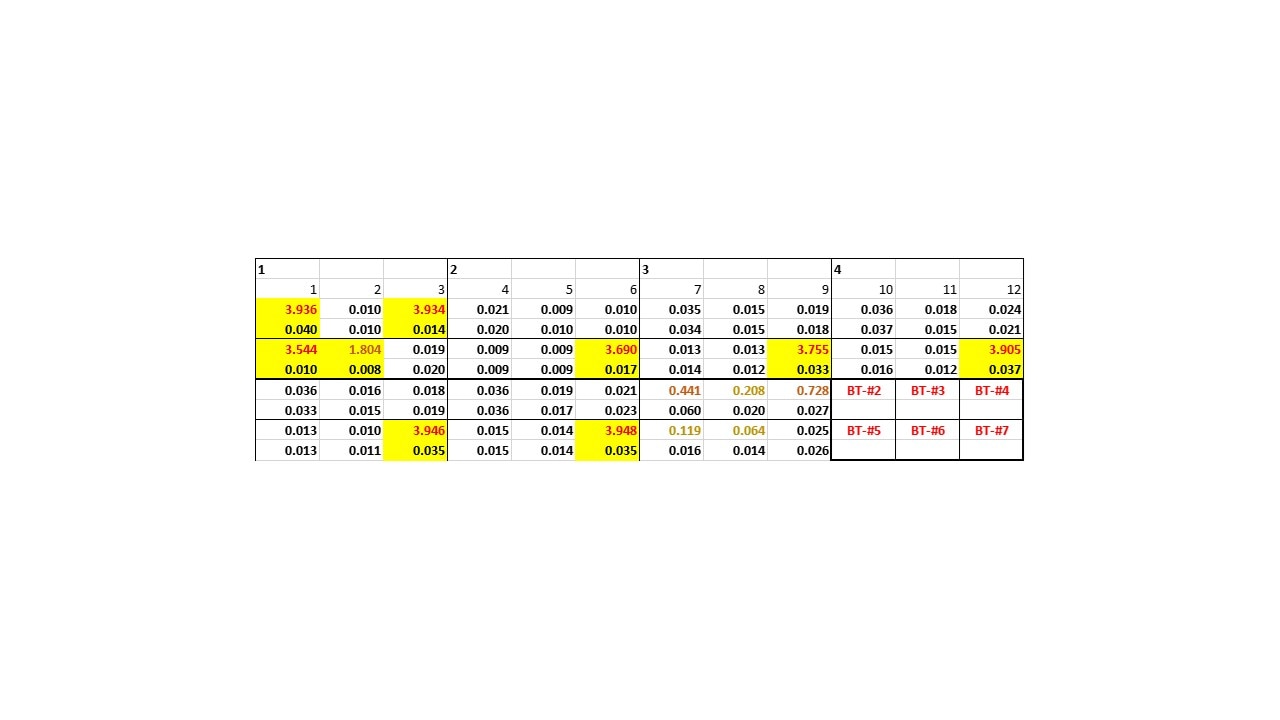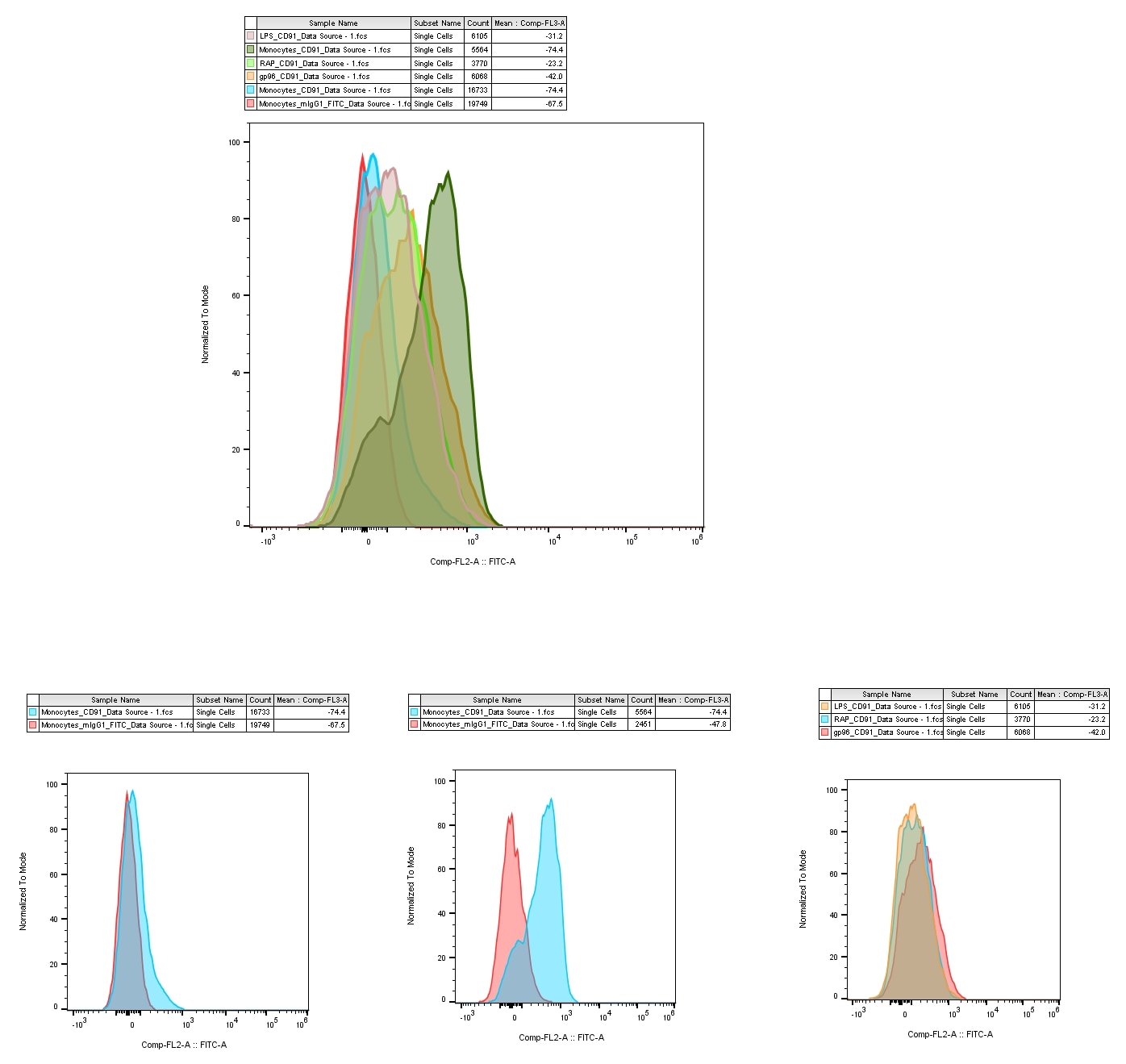Recombinant Human TNF-alpha (HEK293-expressed) Protein, CF
Recombinant Human TNF-alpha (HEK293-expressed) Protein, CF Summary
- R&D Systems HEK293-derived Recombinant Human TNF-alpha (HEK293-expressed) Protein (10291-TA)
- Quality control testing to verify active proteins with lot specific assays by in-house scientists
- All R&D Systems proteins are covered with a 100% guarantee
Product Specifications
Val77-Leu233
Analysis
Product Datasheets
Carrier Free
CF stands for Carrier Free (CF). We typically add Bovine Serum Albumin (BSA) as a carrier protein to our recombinant proteins. Adding a carrier protein enhances protein stability, increases shelf-life, and allows the recombinant protein to be stored at a more dilute concentration. The carrier free version does not contain BSA.
In general, we advise purchasing the recombinant protein with BSA for use in cell or tissue culture, or as an ELISA standard. In contrast, the carrier free protein is recommended for applications, in which the presence of BSA could interfere.
10291-TA
| Formulation | Lyophilized from a 0.2 μm filtered solution in PBS with Trehalose. |
| Reconstitution | Reconstitute at 500 μg/mL in PBS. |
| Shipping | The product is shipped at ambient temperature. Upon receipt, store it immediately at the temperature recommended below. |
| Stability & Storage: | Use a manual defrost freezer and avoid repeated freeze-thaw cycles.
|
Scientific Data
 View Larger
View Larger
Recombinant human TNF-alpha (Catalog # 10291-TA) has a molecular weight (MW) of 52.3 kDa as analyzed by SEC-MALS, suggesting that this protein is a homotrimer. MW may differ from predicted MW due to post-translational modifications (PTMs) present (i.e. Glycosylation).
 View Larger
View Larger
Recombinant Human TNF‑ alpha (HEK293-expressed) (Catalog # 10291-TA) induces cytotoxicity in the L‑929 mouse fibroblast cell line in the presence of the metabolic inhibitor actinomycin D. The ED50 for this effect is 20‑100 pg/mL.
 View Larger
View Larger
2 μg/lane of Recombinant Human TNF-alpha (HEK293-expressed) (Catalog # 10291-TA) was resolved with SDS-PAGE under reducing (R) and non-reducing (NR) conditions and visualized by Coomassie® Blue staining, showing bands at 14-18 kDa.
Reconstitution Calculator
Background: TNF-alpha
Tumor necrosis factor alpha (TNF-alpha ), also known as cachectin and TNFSF2, is the prototypic ligand of the TNF superfamily. It is a pleiotropic molecule that plays a central role in inflammation, immune system development, apoptosis, and lipid metabolism (1, 2). Human TNF-alpha consisits of a 35 amino acid (aa) cytoplasmic domain, a 21 aa transmembrane segment, and a 177 aa extracellular domain (ECD) (3). Within the ECD, human TNF-alpha shares 97% aa sequence identity with rhesus and 71%-92% with bovine, canine, cotton rat, equine, feline, mouse, porcine, and rat TNF-alpha. TNF-alpha is produced by a wide variety of immune, epithelial, endothelial, and tumor cells (1, 2). TNF-alpha is assembled intracellularly to form a noncovalently linked homotrimer which is expressed on the cell surface (4). Cell surface TNF-alpha can induce the lysis of neighboring tumor cells and virus infected cells, and it can generate its own downstream cell signaling following ligation by soluble TNFR I (2, 5). Shedding of membrane bound TNF-alpha by TACE/ADAM17 releases the bioactive cytokine, a 55 kDa soluble trimer of the TNF-alpha extracellular domain (6-8). TNF-alpha binds the ubiquitous 55-60 kDa TNF RI (9, 10) and the hematopoietic cell-restricted 80 kDa TNF RII (11, 12), both of which are also expressed as homotrimers (1, 2, 13). Both type I and type II receptors bind TNF-alpha with comparable affinity (14), although only TNF RI contains a cytoplasmic death domain which triggers the activation of apoptosis. Soluble forms of both types of receptors are released and can neutralize the biological activity of TNF-alpha (15).
- Zelova, H. and J. Hosek (2013) Inflamm. Res. 62:641.
- Juhasz, K. et al. (2013) Expert Rev. Clin. Immunol. 9:335.
- Pennica, D. et al. (1984) Nature 312:724.
- Tang, P. et al. (1996) Biochemistry 35:8216.
- Perez, C. et al. (1990) Cell 63:251.
- Black, R.A. et al. (1997) Nature 385:729.
- Moss, M.L. et al. (1997) Nature 385:733.
- Gearing, A.J.H. et al. (1994) Nature 370:555.
- Schall, T.J. et al. (1990) Cell 61:361.
- Loetscher, H. et al. (1990) Cell 61:351.
- Dembic, Z. et al. (1990) Cytokine 2:231.
- Smith, C.A. et al. (1990) Science 248:1019.
- Loetscher, H. et al. (1991) J. Biol. Chem. 266:18324.
- Pinckard, J.K. et al. (1997) J. Biol. Chem. 272:10784.
- Engelmann, H. et al. (1990) J. Biol. Chem. 265:1531.
Citations for Recombinant Human TNF-alpha (HEK293-expressed) Protein, CF
R&D Systems personnel manually curate a database that contains references using R&D Systems products. The data collected includes not only links to publications in PubMed, but also provides information about sample types, species, and experimental conditions.
12
Citations: Showing 1 - 10
Filter your results:
Filter by:
-
Differential immune- and apoptosis-related gene signatures in pancreatic alpha and beta cells contribute to their fate in type 1 diabetes
Authors: Yi, X;Martin-Vazquez, E;Jawurek, S;Zimath, PL;Oliveira, JG;Costa-Junior, JM;Ilegems, E;Wesley, JD;Title, AC;Yesildag, B;Eizirik, DL;
bioRxiv : the preprint server for biology
Species: Human
Sample Types: Whole Tissue
Applications: Bioassay -
TBK1 Targeting Is Identified as a Therapeutic Strategy to Enhance CAR T-Cell Efficacy Using Patient-Derived Organotypic Tumor Spheroids
Authors: Sun, Y;Maggs, L;Panda, A;Wright, SJ;Cicerchia, AM;Jenney, A;Perricone, MD;Mills, CE;Cattaneo, G;Ventin, M;Chen, F;Rasmussen, MQ;Miranda, A;Revach, OY;Fang, J;Fu, A;Bowling, PJ;Sharova, T;Lawless, A;Sorger, PK;Bardeesy, N;Wang, X;Flaherty, KT;Boland, GM;Mehta, A;Sade-Feldman, M;Ferrone, CR;Jenkins, RW;
Cancer immunology research
Species: Human
Sample Types: Whole Cells
Applications: Cell Culture -
NI-3201 Is a Bispecific Antibody Mediating PD-L1-Dependent CD28 Co-stimulation on T Cells for Enhanced Tumor Control
Authors: Majocchi, S;Lloveras, P;Nouveau, L;Legrand, M;Viandier, A;Malinge, P;Charreton, M;Raymond, C;Pace, E;Millard, B;Svensson, L;Kelpas, V;Anceriz, N;Salgado-Pires, S;Daubeuf, B;Magistrelli, G;Gueneau, F;Moine, V;Masternak, K;Shang, L;Fischer, N;Ferlin, W;
Cancer Immunology Research
Species: Human
Sample Types: Whole Cells
Applications: Bioassay -
Polymeric immunoglobulin receptor promotes Th2 immune response in the liver by increasing cholangiocytes derived IL-33: a diagnostic and therapeutic biomarker of biliary atresia
Authors: Li, Y;Li, TY;Qiao, Q;Zhang, MT;Tong, MX;Xu, LF;Zhang, ZB;
EBioMedicine
Species: Human
Sample Types: Whole Cells
Applications: Cell Culture -
TNF Induces Laminin-332-Encoding Genes in Endothelial Cells and Laminin-332 Promotes an Atherogenic Endothelial Phenotype
Authors: Hayderi, A;Zegeye, MM;Meydan, S;Sirsjö, A;Kumawat, AK;Ljungberg, LU;
International journal of molecular sciences
Species: Human
Sample Types: Whole Cells
Applications: Bioassay -
Blood DNA methylation profiling identifies cathepsin Z dysregulation in pulmonary arterial hypertension
Authors: Ulrich, A;Wu, Y;Draisma, H;Wharton, J;Swietlik, EM;Cebola, I;Vasilaki, E;Balkhiyarova, Z;Jarvelin, MR;Auvinen, J;Herzig, KH;Coghlan, JG;Lordan, J;Church, C;Howard, LS;Pepke-Zaba, J;Toshner, M;Wort, SJ;Kiely, DG;Condliffe, R;Lawrie, A;Gräf, S;Morrell, NW;Wilkins, MR;Prokopenko, I;Rhodes, CJ;
Nature communications
Species: Human
Sample Types: Whole Cells
Applications: Bioassay -
In vitro and In vivo evidence demonstrating chronic absence of Ref-1 Cysteine 65 impacts Ref-1 folding configuration, redox signaling, proliferation and metastasis in pancreatic cancer
Authors: Mijit, M;Kpenu, E;Chowdhury, NN;Gampala, S;Wireman, R;Liu, S;Babb, O;Georgiadis, MM;Wan, J;Fishel, ML;Kelley, MR;
Redox biology
Species: Human
Sample Types: Transfected Whole Cells
Applications: Bioassay -
Cytokine-Induced iNOS in A549 Alveolar Epithelial Cells: A Potential Role in COVID-19 Lung Pathology
Authors: Barilli, A;Recchia Luciani, G;Visigalli, R;Sala, R;Soli, M;Dall'Asta, V;Rotoli, BM;
Biomedicines
Species: Human
Sample Types: Transfected Whole Cells, Whole Cells
Applications: Bioassay -
An integrated organoid omics map extends modeling potential of kidney disease
Authors: Lassé, M;El Saghir, J;Berthier, CC;Eddy, S;Fischer, M;Laufer, SD;Kylies, D;Hutzfeldt, A;Bonin, LL;Dumoulin, B;Menon, R;Vega-Warner, V;Eichinger, F;Alakwaa, F;Fermin, D;Billing, AM;Minakawa, A;McCown, PJ;Rose, MP;Godfrey, B;Meister, E;Wiech, T;Noriega, M;Chrysopoulou, M;Brandts, P;Ju, W;Reinhard, L;Hoxha, E;Grahammer, F;Lindenmeyer, MT;Huber, TB;Schlüter, H;Thiel, S;Mariani, LH;Puelles, VG;Braun, F;Kretzler, M;Demir, F;Harder, JL;Rinschen, MM;
Nature communications
Species: Human
Sample Types: Whole Cells
Applications: Bioassay -
Therapy-induced APOBEC3A drives evolution of persistent cancer cells
Authors: Isozaki, H;Sakhtemani, R;Abbasi, A;Nikpour, N;Stanzione, M;Oh, S;Langenbucher, A;Monroe, S;Su, W;Cabanos, HF;Siddiqui, FM;Phan, N;Jalili, P;Timonina, D;Bilton, S;Gomez-Caraballo, M;Archibald, HL;Nangia, V;Dionne, K;Riley, A;Lawlor, M;Banwait, MK;Cobb, RG;Zou, L;Dyson, NJ;Ott, CJ;Benes, C;Getz, G;Chan, CS;Shaw, AT;Gainor, JF;Lin, JJ;Sequist, LV;Piotrowska, Z;Yeap, BY;Engelman, JA;Lee, JJ;Maruvka, YE;Buisson, R;Lawrence, MS;Hata, AN;
Nature
Species: Human
Sample Types: Whole Cells
Applications: Immunofluorescence -
GPR84 regulates pulmonary inflammation by modulating neutrophil functions
Authors: SW Wang, Q Zhang, D Lu, YC Fang, XC Yan, J Chen, ZK Xia, QT Yuan, LH Chen, YM Zhang, FJ Nan, X Xie
Acta pharmacologica Sinica, 2023-04-04;0(0):1-11.
Species: Mouse
Sample Types: Whole Cells
Applications: Bioassay -
Lactobacillus rhamnosus postbiotic-induced immunomodulation as safer alternative to the use of live bacteria
Authors: S Salva, I Tiscornia, F Gutiérrez, S Alvarez, M Bollati-Fo
Cytokine, 2021-07-10;146(0):155631.
Species: Human
Sample Types: Whole Cells
Applications: Bioassay
FAQs
No product specific FAQs exist for this product, however you may
View all Proteins and Enzyme FAQsReviews for Recombinant Human TNF-alpha (HEK293-expressed) Protein, CF
Average Rating: 4.6 (Based on 5 Reviews)
Have you used Recombinant Human TNF-alpha (HEK293-expressed) Protein, CF?
Submit a review and receive an Amazon gift card.
$25/€18/£15/$25CAN/¥75 Yuan/¥2500 Yen for a review with an image
$10/€7/£6/$10 CAD/¥70 Yuan/¥1110 Yen for a review without an image
Filter by:
















